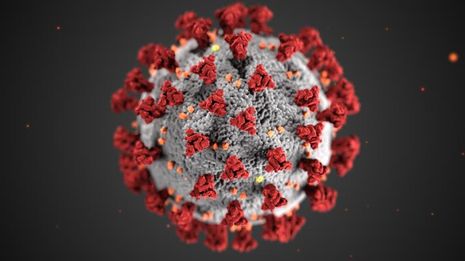This Week In COVID-19 Research
Laura Ryan explores and summarises some of the most recent scientific papers looking at the epidemiology of the coronavirus in this weekly installment.

While most Cambridge students are stuck at home desperately scanning their inboxes for news about exams, one thing there’s no shortage of is news about COVID-19. The sheer volume of information out there is overwhelming, with vaccine trials in animals and humans regularly making the national press. The purpose of this article is to go a little deeper, and provide you with a brief summary of some of the most important academic papers published over the past few weeks in SARS-CoV-2 research. It is by no means an exhaustive list, but it contains some of the highlights that haven’t made it into the mainstream media.
Preliminary support for a ‘dry swab, extraction free’ protocol for SARS-CoV-2 testing via RT-qPCR
– bioRxiv
“Their procedure... is in fact an improvement on conventional extraction methods.”
Demand for accurate genetic SARS-CoV-2 testing far exceeds current supply. This shortage is partly due to the relative scarcity of some of the solutions that are used to store patient swabs, and then to extract viral DNA. To compensate for this, a team from the University of Washington have been working on a ‘dry swab, extraction free’ technique that can detect viral DNA in a sample, without the need for the valuable solutions. Their procedure correctly detected SARS-CoV-2 in 9 out of 11 samples, which is in fact an improvement on conventional extraction methods. The researchers hope that their technique will vastly improve the simplicity and efficiency of SARS-CoV-2 testing.
Find the paper here.
Rapid reconstruction of SARS-CoV-2 using a synthetic genomics platform
- Nature
Once the genome sequence of a virus has been published (the genome sequence for SARS-CoV-2 is freely available online), it is possible for researchers to reconstruct the virus in a lab, using either fragments of virus from patients, or fragments of DNA that are synthesised chemically by biotech companies. To generate a functional virus, these fragments first have to be ‘stitched together’ using a variety of molecular techniques. The problem with coronaviruses is that they have some of the largest genomes of any RNA viruses, which makes creating and manipulating their genetic material very tricky and slow. This paper details a new technique for generating the SARS-CoV-2 virus from fragments in one step, and in only a week. The ability to create functional virus quickly is a huge benefit to researchers, who can use synthesised viruses for functional studies (how the virus replicates itself, infects cells, and affects different types of cells), to make vaccines, or for drug discovery.
Find this paper here.
Changes in contact patterns shape the dynamics of the COVID-19 outbreak in China
– Science
“strict lockdown in Shanghai and Wuhan... was sufficient to curb the spread of the disease.”
Perhaps the most important current question for epidemiologists and statisticians all over the world is ‘what can we learn from cities who have brought their coronavirus outbreaks under control?’ This paper represents a collaboration between Chinese and Italian researchers, and demonstrates that the introduction of strict lockdown in Shanghai and Wuhan reduced the number of individuals a resident met per day from 15-20 to just 2 per day (roughly), which was sufficient to curb the spread of the disease. They also conclude that, based on their Shanghai research, closure of schools alone would not have been able to achieve a similar result, but it did reduce the intensity of the peak significantly, providing relief to hospitals. A second paper from the University of Southampton compares the efficacy of the different types of social measures implemented in China, and concludes that rapid detection and isolation of cases had the greatest effect, but a combination of measures, including travel restrictions and social distancing, was necessary to bring the epidemic under control.
Find this paper here.
Paper from the University of Southampton here.
SARS-CoV-2 receptor ACE2 is an interferon-stimulated gene in human airway epithelial cells and is detected in specific cell subsets across tissue
– Cell
When the SARS-CoV-2 virus invades human cells, it needs the help of one of our proteins present on the cell surface, called ACE2. This paper, published by teams from MIT and Harvard, firstly shows which types of cell in the human body express the ACE2 protein, and are thus susceptible to viral infection. As you might expect, they include specific types of cells in the lung, nose, and intestines. They then go on to show that the ACE2 protein is in fact involved in our immune response against viral infection, suggesting that SARS-CoV-2 may be ‘hijacking’ our innate antiviral response to facilitate its own invasion.
Find this paper here.
Structural basis for inhibition of the RNA-dependent RNA polymerase from SARS-CoV-2 by Remdesivir
- Science
This paper contains an in-depth analysis of the structure of a specific viral protein that the SARS-CoV-2 virus requires to replicate itself, named RNA-dependent RNA Polymerase (RdRp). This protein is the target of the drug Remdesivir, recently approved for use in the US. They make use of a technique called cryogenic electron microscopy to investigate the physical structure of the RdRp protein in exceptionally high resolution. They also show exactly how the Remdesivir molecule fits into, and blocks the activity of, this protein - opening the door to the design of other antiviral therapies based on the same paradigm. This particular paper was submitted to the journal ‘Science’ by a team from China, while a very similar paper entitled “Structure of replicating SARS-CoV2 polymerase” was published at roughly the same time by a team from Germany.
Find this paper here, and the German paper here.
 News / Downing investigates ‘mysterious’ underground burial vault 29 December 2025
News / Downing investigates ‘mysterious’ underground burial vault 29 December 2025 News / Unions protest handling of redundancies at Epidemiology Unit30 December 2025
News / Unions protest handling of redundancies at Epidemiology Unit30 December 2025 Lifestyle / Ask Auntie Alice29 December 2025
Lifestyle / Ask Auntie Alice29 December 2025 Features / ‘Treated like we’re incompetent’: ents officers on college micromanagement30 December 2025
Features / ‘Treated like we’re incompetent’: ents officers on college micromanagement30 December 2025 Science / Astronomical events to look out for over the break29 December 2025
Science / Astronomical events to look out for over the break29 December 2025










